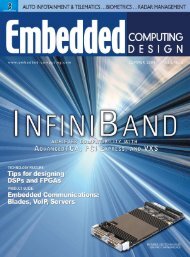CompactPCI and AdvancedTCA Systems - OpenSystems Media
CompactPCI and AdvancedTCA Systems - OpenSystems Media
CompactPCI and AdvancedTCA Systems - OpenSystems Media
Create successful ePaper yourself
Turn your PDF publications into a flip-book with our unique Google optimized e-Paper software.
SPECIALHIGH-END EMBEDDED COMPUTINGplatform size is driving developers to dramaticallyreduce the cost of the payloads.What’s needed are attributable platformpayloadsolutions that still exhibit appropriatelevels of reliability to match theforecasted life expectancies of the platform.A first-order approximation of systemflyaway costs is $10,000 per pound. Thisfigure was developed many years ago on amultispectral Electronic Warfare (EW) systemdevelopment involving six major EWcompanies <strong>and</strong> has survived many technologyshifts. Technology has provided morecapabilities per pound, but this approximationhas still proven to be adequate forrapidly approximating system costs.System requirementsThe first basic requirement is that the signalprocessing systems must be physicallysmall enough to fit into the new platforms.For many platforms, the commonly used6U VME systems are just too big; 1U, 2U,or 3U form factor solutions are needed.In addition, the signal processing systemsmust adhere to industry st<strong>and</strong>ards forboard design <strong>and</strong> interfaces, if systemsdesigners are to benefit from CommercialOff-the-Shelf (COTS) solutions.Squeezing the processing power of 6Uboards into smaller form factors dem<strong>and</strong>sthe creative use of a specialized adjunctprocessor. Adjunct processors are devicessuch as Field Programmable Gate Arrays(FPGAs) <strong>and</strong> ASICs, dedicated to a specificcomputationally intensive operation.Because adjunct processors execute asingle task, they can do it with extraordinaryspeed <strong>and</strong> efficiency. Developerscan partition signal processing operationsamong different types of processors formaximum efficiency, getting more donein less space while accepting the tradeoffof somewhat greater system complexity.True multisensor flexibility dem<strong>and</strong>s thesignal processing engine have a varietyof I/O options, all with high-b<strong>and</strong>widthinterconnects to the processors. Ideally,these I/O options connect directly to theprocessing boards, as well as supportingsome form of an industry-st<strong>and</strong>ard mezzaninecard.operate in harsh environments, they mustbe able to withst<strong>and</strong> shock, vibration, <strong>and</strong>temperature extremes.Processing density <strong>and</strong> efficiencyOne approach for achieving processingdensity <strong>and</strong> efficiency for signal processingis to leverage adjunct processingengines such as FPGAs as programmableprocessors. For some front-end signal <strong>and</strong>image processing functions, FPGAs havedemonstrated a 10- to 20-fold performanceboost over a PowerPC G4 processor.However, some front-end tasks, suchas filter weight computation <strong>and</strong> mostback-end processing, still perform muchbetter on a PowerPC processor. In fittingthe most processing power in the smallestspace for a given application, the trickis finding not only the optimum balancebetween FPGAs <strong>and</strong> PowerPCs, but alsodetermining exactly which model of eachchip to choose.Application software can be partitionedso that certain algorithms go onto theFPGA. FPGA-appropriate algorithmsinclude fixed-point computations or non-Since engineers develop functional softwareaccording to an overall project schedule,they need access to adequate developmenttools, including algorithm libraries <strong>and</strong>I/O device drivers. If adjunct processorsare employed, efficient development toolsmust support them. And lastly, becausethese systems are often called upon toRSC# 27 @www.compactpci-systems.com/rsc<strong>CompactPCI</strong> <strong>and</strong> <strong>AdvancedTCA</strong> <strong>Systems</strong> / June 2005 / 27
















